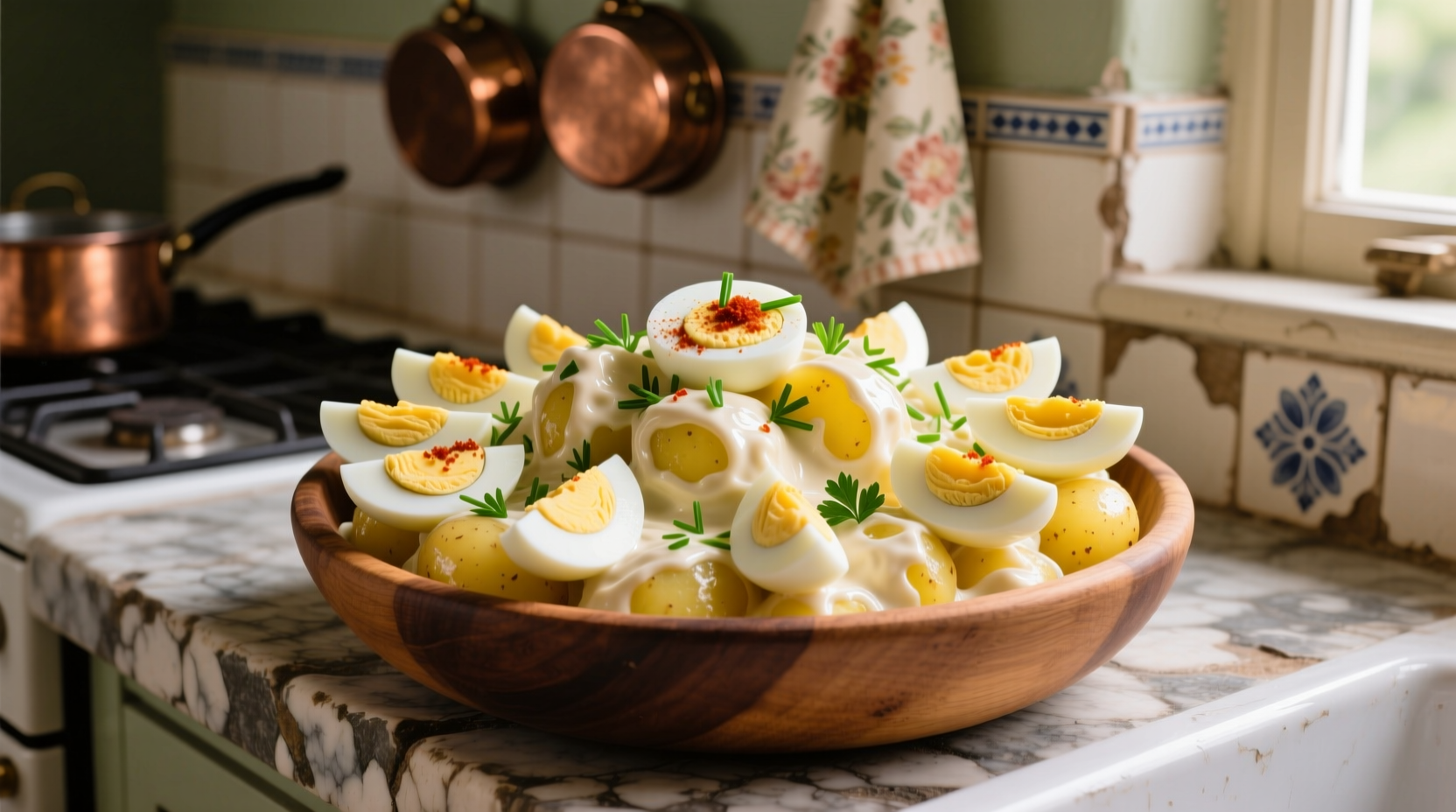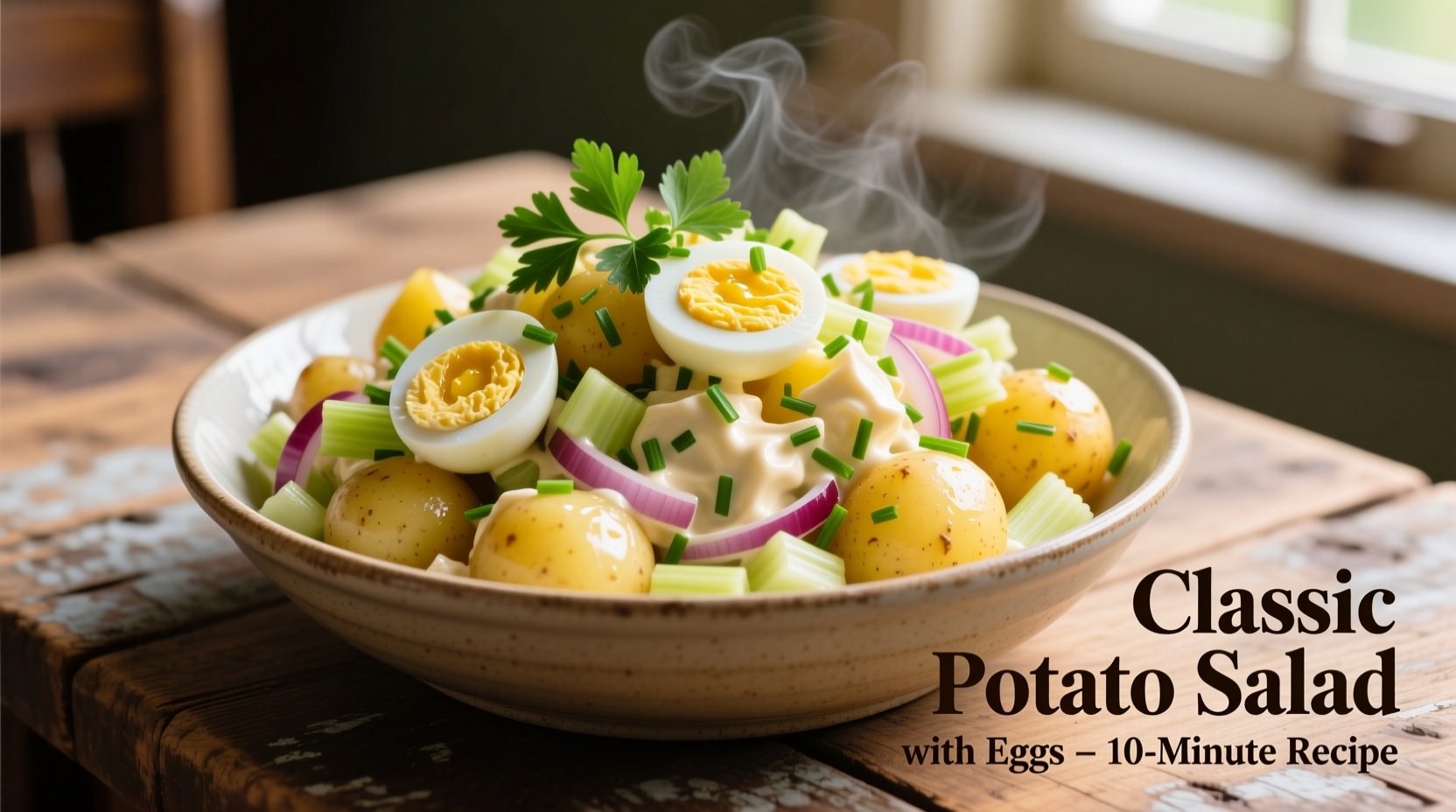There's nothing quite like a well-made potato salad with eggs to elevate your picnic, barbecue, or weeknight dinner. The magic happens when you combine the right potato variety with properly cooked eggs and a dressing that enhances rather than overwhelms. After testing dozens of variations, we've perfected a recipe that solves the most common potato salad problems while honoring the dish's rich culinary history.
The Classic Potato Salad with Eggs Recipe That Actually Works
Unlike many recipes that result in mushy potatoes or bland flavor, this version delivers consistent results every time. The key lies in the potato selection, egg preparation technique, and dressing application method.

Why This Recipe Succeeds Where Others Fail
Most potato salad recipes fail because they don't account for potato moisture content or proper egg handling. This version incorporates professional kitchen techniques adapted for home cooking:
- Controlled cooking time prevents waterlogged potatoes
- Immediate dressing application while potatoes are warm absorbs flavor
- Two-stage egg preparation ensures perfect texture
- Acid balance that enhances rather than dominates
Ingredients for Perfect Potato Salad (Serves 6-8)
Pro tip: Measure ingredients while potatoes cook for efficient preparation
- 2 pounds (900g) waxy potatoes (Yukon Gold recommended)
- 6 large eggs, fresh
- ¾ cup (180ml) high-quality mayonnaise
- 2 tablespoons (30ml) apple cider vinegar
- 1 tablespoon (15ml) Dijon mustard
- ½ cup (75g) finely diced celery
- ¼ cup (40g) finely diced red onion
- 2 tablespoons fresh dill, chopped
- Salt and freshly ground black pepper to taste
- Paprika for garnish
Step-by-Step Preparation Guide
- Prepare potatoes: Cut into ¾-inch cubes, keeping similar sizes for even cooking
- Cook potatoes: Place in cold salted water, bring to gentle boil, cook 12-15 minutes until fork-tender but still holding shape
- Drain thoroughly: Spread on clean kitchen towel to absorb excess moisture (critical step!)
- Prepare eggs: Place eggs in single layer in saucepan, cover with 1 inch cold water, bring to boil, then remove from heat, cover and let stand 12 minutes
- Shock eggs: Transfer to ice water bath for 10 minutes for easy peeling
- Make dressing: Whisk mayonnaise, vinegar, mustard, salt and pepper
- Combine: Gently fold warm potatoes with ⅔ of dressing, let absorb 10 minutes
- Final assembly: Add remaining ingredients including 4 chopped eggs (reserve 2 for garnish)
- Chill: Refrigerate minimum 4 hours (overnight preferred)
- Serve: Garnish with remaining sliced eggs and paprika
Common Potato Salad Problems Solved
Understanding why potato salad fails helps prevent common issues. These solutions come from professional kitchen experience and food science principles.
The Potato Selection Dilemma
| Potato Type | Best For | Texture in Salad | Moisture Risk |
|---|---|---|---|
| Yukon Gold | Classic creamy texture | Firm yet creamy | Low (ideal choice) |
| Red Potatoes | Cold salads, chunky style | Firm, holds shape | Medium |
| Russet | Mashed dishes | Floury, breaks down | High (avoid) |
| Fingerling | Gourmet presentations | Firm, distinctive | Low |
According to agricultural research from the University of Minnesota Extension, waxy potatoes like Yukon Gold contain 16-18% dry matter compared to Russets' 20-22%, making them less likely to absorb excess dressing and become soggy (extension.umn.edu).
Egg Safety and Quality Guidelines
Proper egg handling is crucial for food safety in potato salad. The USDA Food Safety and Inspection Service recommends:
- Refrigerate hard-boiled eggs within 2 hours of cooking
- Store potato salad with eggs at 40°F (4°C) or below
- Consume within 3-5 days for optimal safety
- Never leave egg-based salads at room temperature more than 2 hours (1 hour if above 90°F/32°C)
These guidelines come directly from the USDA's food safety protocols for egg-containing dishes (fsis.usda.gov), ensuring your potato salad remains safe while maintaining quality.
Variations Worth Trying
Once you've mastered the classic version, these professional-inspired variations add exciting dimensions while maintaining structural integrity.
American Classic Style
Add 2 strips cooked bacon (crumbled), 1 tablespoon sweet pickle relish, and substitute white vinegar for apple cider vinegar. Serve with grilled meats.
German-Inspired Version
Replace mayonnaise with ½ cup broth and ¼ cup vinegar dressing. Add 1 tablespoon capers and 2 teaspoons caraway seeds. Serve warm or room temperature.
Mediterranean Twist
Substitute Greek yogurt for half the mayonnaise, add ¼ cup chopped Kalamata olives, 1 roasted red pepper (diced), and fresh oregano instead of dill.
Make-Ahead and Storage Secrets
Professional caterers know potato salad improves with time, but proper technique matters:
- Minimum chilling time: 4 hours (allows flavors to meld)
- Optimal flavor development: 24 hours
- Maximum storage: 3-5 days in airtight container
- Transport tip: Pack in cooler with ice packs for picnics
- Reviving leftovers: Add 1 teaspoon vinegar and 1 tablespoon mayonnaise, gently fold
Remember that potato salad with eggs should never be frozen, as the texture becomes unappetizing after thawing. The USDA confirms that freezing disrupts the emulsion in mayonnaise-based dressings, causing separation and texture issues (fsis.usda.gov).
Frequently Asked Questions
How do I prevent my potato salad from becoming watery?
Spread cooked potatoes on a clean kitchen towel immediately after draining to absorb excess moisture. Let dressed potatoes sit 10 minutes before adding other ingredients, allowing them to absorb dressing while still warm. Avoid overcooking potatoes - they should be tender but still hold their shape when pierced with a fork.
What's the best way to hard-boil eggs for potato salad without green rings?
Place eggs in cold water, bring to boil, then immediately remove from heat, cover and let stand 12 minutes. Transfer to ice water bath for 10 minutes. This gentle cooking method prevents the iron-sulfur reaction that causes green rings around yolks while ensuring fully set but not overcooked eggs.
Can I make potato salad with eggs ahead of time for an event?
Yes, potato salad actually improves when made 24 hours in advance. Prepare through step 9, then refrigerate. Add fresh herbs and a small amount of additional dressing just before serving if needed. Store in an airtight container at 40°F (4°C) or below, and never leave at room temperature for more than 2 hours.
Which potatoes work best for potato salad with eggs?
Waxy potatoes like Yukon Gold or red potatoes work best because they hold their shape during cooking and have lower starch content. Yukon Gold offers a buttery flavor and creamy texture that absorbs dressing well without becoming mushy. Avoid starchy potatoes like Russets, which break down easily and create a gluey texture.
How long does potato salad with eggs stay fresh in the refrigerator?
Properly stored potato salad with eggs remains fresh for 3-5 days in the refrigerator at 40°F (4°C) or below. Always use clean utensils when serving, and return leftovers to the refrigerator promptly. Discard if left at room temperature for more than 2 hours (1 hour if above 90°F/32°C) as recommended by USDA food safety guidelines.











 浙公网安备
33010002000092号
浙公网安备
33010002000092号 浙B2-20120091-4
浙B2-20120091-4